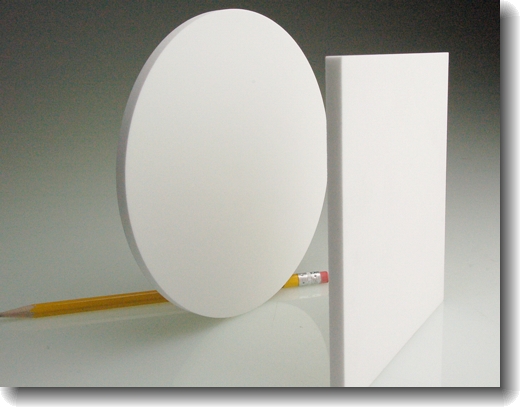Frit Porosity and Sizes
Frits come in differing standard porosities, and a full range of diameters, from tiny to 380 mm. We can provide frits of all porosities and various diameters, although stock sizes will always be less expensive. We are distributors for the excellent ROBU porous glass filters, and stock mostly their frits, so the P- series porosities will be our first choice during the design process.
A graph of flow rates for air and water for various porosities (in the European ISO 4793 system) is available as a pdf.

Custom and precision dimensions and custom shapes are available as special orders from Germany.
European Porosity Designations
|
Designation
|
Pore size, in microns
|
|
P00 (P500)
|
250-500 µm
|
|
P0 (P250)
|
160-250 µm
|
|
P1 (P160)
|
100-160 µm
|
|
P2 (P100)
|
40-100 µm
|
|
P3 (P40)
|
16-40 µm
|
|
P4 (P16)
|
10-16 µm
|
|
P5 (P1.6)
|
1.0-1.6 µm
|
American Porosity Designations
|
Designation
|
Pore size, in microns
|
|
Extra Coarse
|
170-220 µm
|
|
Coarse
|
40-60 µm
|
|
Medium
|
10-15 µm
|
|
Fine
|
4-5.5 µm
|
|
Very Fine
|
2-2.5 µm
|
|
Ultra Fine
|
0.9-1.4 µm
|
Ace Glass
Ace makes their filters from fibers, rather than particles.
We don't stock them, but could obtain them as a special order.
| Designation | Pore size, in microns |
| A | 145-174 µm |
| B | 70-100 µm |
| C | 25-50 µm |
| D | 10-20 µm |
| E | 4-8 µm |
|
Each of the three systems of pore size specification generally cover your common needs. There are a few specialized porosities in the finer range, such as 0.5 - .75 µm, in limited thicknesses and diameters. Porosities of sintered glass filters are determined dynamically: air is forced through a frit just immersed in water until a bubble goes through. The pressure required correlates with the pore size, according to theory: pore diameter (in microns) = 30 * surface tension (in dynes/cm) / pressure (in mm HG). This should correlate with the average pore size of the whole frit. This also says nothing about the specific shape of the pores; some could be long and narrow, with the same functional aperture as those that are closer to round. If the material you are filtering is not uniform in size, but rather a distribution of sizes, the likelihood of particles clogging the frit is large. Your mileage may vary. There are pdf's of technical information about frits: Pore volumes and surface areas and pore properties vary with the porosity. Graph of flow rates for air and water for various porosities (in the European ISO 4793 system). |


